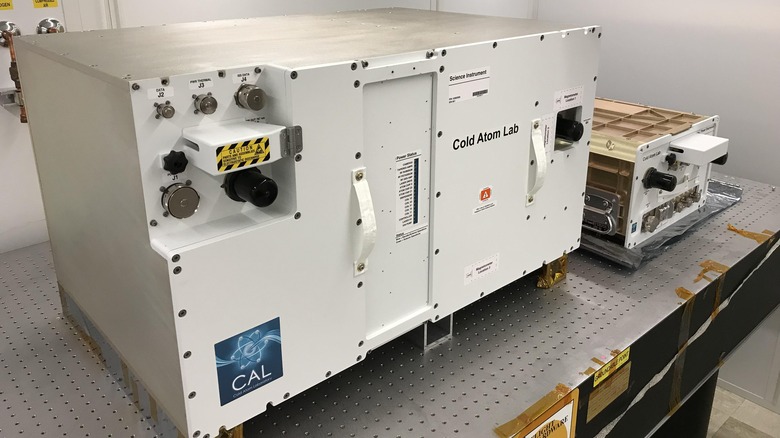Why Some Of The Coolest Science Experiments Are Done In Space
There's a ton of science research that's done on the International Space Station, from space-specific research like looking into the effects of spaceflight on the human body or investigations into how to grow crops in orbit, to human health research like the development of new drugs and new drug delivery systems. But there's other work done there too, even into issues of fundamental physics.
Some of the most high-concept research is into quantum phenomena, using the unique microgravity environment of the space station to research the behavior of atoms in a way that wouldn't be possible on Earth's surface. A unique research instrument called the Cold Atom Laboratory makes it possible to cool atoms to almost absolute zero, the technical name for a temperature of zero kelvins or -459.67 Fahrenheit. This is the coldest temperature possible — when atoms are so cold that they essentially stop moving.
By cooling atoms down to within less than a degree of absolute zero, researchers can observe them in a state even colder than solids, which can be used for looking into all sorts of physics problems. "What we're doing with cold atom science in general is looking for and learning about new tools that nature gives us," said project scientist for the Cold Atom Lab, Jason Williams of NASA's Jet Propulsion Laboratory. "It's like we've discovered a hammer and we're just starting to investigate all the ways we could use it."
How scientists use the Cold Atom Lab
The Cold Atom Laboratory consists of a pair of lockers that look much like any other locker that you might find in spaceflight, but its ability to reach such cold temperatures means it can be used for extreme precision experiments. The ultra-cold temperatures let atoms reach a state called Bose-Einstein Condensate (BEC), the fifth state of matter (other than solid, liquid, gas, and plasma), which is the first time this has been achieved in orbit. In this state, atoms live for longer than normal, making it a great way to study quantum phenomena. That's because without the atoms moving around like they normally do, they behave more like waves than particles, which makes them easier to study.
The Cold Atom Lab makes use of the station's microgravity environment to generate these BECs. On Earth, systems for creating BECs can only create particles that exist for less than a second, because gravity pulls the particles out of their containers. But with essentially no gravity on the space station, the particles can last between five and 10 seconds, allowing much more detailed observations. The lab can also repeat measurements several times over a day.
"I really think we've just begun to scratch the surface of what can be done with ultracold atom experiments in microgravity," said a member of the Cold Atom Lab science team at JPL, Ethan Elliott. "I'm really excited to see what the fundamental physics community does with this capability in the long term."
Upgrading the Cold Atom Lab
Part of what makes the Cold Atom Lab so special is that it can be upgraded by the astronauts who live and work on the space station. In 2020, astronauts upgraded the hardware of the lab to add an instrument called an atom interferometer which uses atoms to measure forces like gravity. It can be used for research into the fundamental theory of gravity, or in planetary science research to see the way that gravity changes across a planet's surface.
A further upgrade occurred in 2023 when astronauts added hardware called the Quantum Observer Module to the lab. This allows the lab to study not only atoms alone but also the interaction of atoms. That means it can study quantum chemistry as well as quantum physics, with researchers controlling the lab remotely from Earth. It has already been used for research published in 2023 into the interactions of two forms of BECs.
In the future, researchers have proposed using the microgravity of the space station to study other topics such as the nature of dark energy, the mysterious force that makes up most of the universe, and using magnetic fields to manipulate and control individual atoms. "We hope that Cold Atom Lab will mark the start of an era where quantum tools are used regularly in space," said the project manager for Cold Atom Lab at NASA's Jet Propulsion Laboratory, Kamal Oudrhiri. "Because of Cold Atom Lab, we've shown that these delicate quantum tools are reliable and even upgradable in space. It's our hope that Cold Atom Lab will be just the first of many quantum space missions to come."
